Disclosure: We may earn commissions if you purchase products after clicking on a link from our site.
Do you want to take more crappie home? Would you like to return home with a cooler full of crappies? Crappie is a fish in the sunfish family that can be found in many areas. It is tasty and puts up a good fight despite its size. If you would like to learn how to catch more crappies, then we shared crappie fishing tips to help you get more crappies on your dinner table.
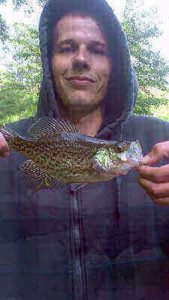
Table of Contents
- 1 How To Catch Crappie
- 2 Crappie Fishing Setup
- 3 How To Catch Crappie From The Bank
- 4 How To Catch Crappie In Winter
- 5 How To Catch Crappie With Minnows
- 6 How To Catch Crappie In Winter
- 7 How To Catch Crappie In Summer
- 8 How To Catch Crappie In Fall
- 9 How To Catch Crappie In Texas
- 10 How To Catch Crappie At Night
- 11 How To Catch Crappie In Florida
- 12 How To Catch Crappie From A Boat
- 13 Crappie Fishing Tips
- 14 Crappie Gear
- 15 Best Bait For Crappie
- 16 Best Crappie Lures
- 17 The Bottom Line
How To Catch Crappie
1. Trolling
Trolling is a popular fishing method employed by anglers to target crappies, a sought-after freshwater game fish known for its delicious taste and sporting qualities. This technique involves trailing one or more baited lines behind a moving boat at varying depths and speeds, allowing anglers to cover a wide area of water while presenting their lures or baits to crappies dispersed throughout the water column.
Anglers often utilize small jigs, spinners, or live bait such as minnows or worms to entice crappies into striking. The key to successful trolling for crappies lies in maintaining a consistent speed and depth, as well as experimenting with different lures and presentations to determine what the fish are actively feeding on.
Trolling allows anglers to explore large bodies of water such as lakes or reservoirs, effectively locating schools of crappies and capitalizing on their feeding patterns. With its versatility and ability to cover vast stretches of water, trolling remains a favored method for anglers targeting crappies, promising an enjoyable and rewarding fishing experience.
2. Vertical Jigging
Vertical jigging using live bait or lures can also be used to fish for crappie. Vertical jigging stands out as a highly effective and popular fishing technique utilized by anglers to target crappies, prized freshwater game fish known for their tasty flesh and spirited fights.
This fishing method involves dropping a weighted jig or lure directly beneath the boat, allowing it to sink to the desired depth where crappies are congregated. Anglers then impart subtle or erratic movements to the jig by raising and lowering the rod tip, mimicking the natural motions of small baitfish or insects.
The vertical presentation of the jig enables anglers to precisely target specific areas where crappies are holding, such as submerged structures, brush piles, or drop-offs. Successful vertical jigging for crappies requires keen observation and adjustment of jigging techniques to match the fish’s feeding preferences and behavior.
With its versatility and effectiveness in enticing bites from crappies suspended at various depths, vertical jigging remains a favored method among anglers seeking a thrilling and productive day on the water.
3. Night Fishing
Night fishing for crappies can be an exhilarating and rewarding experience for anglers seeking to target these prized freshwater game fish. This method involves venturing onto the water during the evening or nighttime hours when crappies are more active and likely to feed.
Anglers typically utilize a variety of techniques such as casting with artificial lures or fishing with live bait near submerged structures, docks, or other areas where crappies congregate during low-light conditions. The darkness of the night provides a sense of tranquility and serenity on the water, enhancing the fishing experience.
Additionally, crappies tend to move into shallower waters during the night to feed, making them more accessible targets for anglers. Patience, attention to detail, and using techniques that maximize visibility in low-light conditions are essential for successful night fishing for crappies. Overall, night fishing offers anglers an exciting opportunity to catch crappies while enjoying the peaceful ambiance of the water under the stars.
4. Casting
You can cast for crappie. Casting is one of the popular fishing methods used by anglers to catch many species of fish. Lightweight fishing rods are usually used to cast for crappie.
Casting is a versatile and widely practiced fishing technique utilized by anglers to target crappies, esteemed freshwater game fish known for their delicious taste and spirited fights. This method involves casting lightweight lures or bait rigs with precision to specific areas where crappies are likely to be present, such as near submerged structures, weed beds, or drop-offs.
Anglers often use a variety of artificial lures such as jigs, spinners, or soft plastics, as well as live bait such as minnows or worms, to entice crappies into striking. The key to successful casting for crappies lies in accurately presenting the lure or bait and imparting lifelike movements to mimic natural prey.
Anglers may vary their retrieve speed, depth, and presentation style to match the crappies’ feeding preferences and behavior. With its simplicity and effectiveness in covering a wide range of water depths and structures, casting remains a favored method among anglers seeking an exhilarating and productive day on the water.
5. Fly Fishing
Fly fishing for crappies presents an exciting challenge for anglers seeking a unique and rewarding fishing experience. This method involves using specialized fly rods, reels, and lightweight artificial flies to entice crappies into striking. Anglers typically target crappies in shallow water near submerged structures, weed beds, or drop-offs where these freshwater game fish are known to congregate.
The delicate presentation of the fly mimics the natural movements of insects or small baitfish, enticing crappies to feed. Anglers may employ a variety of fly patterns, including nymphs, streamers, or small poppers, to match the crappies’ preferred forage and provoke strikes.
Fly fishing for crappies requires patience, skill, and precise casting accuracy to effectively present the fly and fool these wary fish. With its artful techniques and immersive experience connecting with nature, fly fishing offers anglers a rewarding and memorable way to pursue crappies on the water.
Crappie Fishing Setup
Crappies can be caught on regular fishing gear. You don’t need any high-tech gear. A light spinning rod and a 1500 to 2000 series spinning reel paired with a 6-pound test monofilament test line will work fine for crappie fishing.
How To Catch Crappie From The Bank
When fishing crappie from the bank, you can use a crappie jig. Simply cast a crappie jig and let it reach the water column you want to target for fish. Then slowly reel it in. This fishing method allows you to cover a lot of water and is very effective when fishing for crappie.
Using a jig is an effective way to fish for crappie. Fishing for crappie early morning and late evening are the best times to target them.
How To Catch Crappie In Winter
When fishing for crappie from the bank in spring, look for shallow bays that have weeds. They are often found in areas with weeds that warm up quickly in the sun. Crappies will be preying on shad and minnows to put back the weight they lost during the winter. Cast in these areas for crappie. Harder bottoms with sand or gravel are also prime areas for targeting crappie.
How To Catch Crappie With Minnows
Live minnows work well when fishing for crappie. Using a rig with minnows is very effective when fishing for crappie with minnows. Thread the minnow on a small hook and cast it into the water. The minnow will swim around which will get the attention of the crappie enticing it to strike.
Additionally, you can also suspend the minnow under a bobber and watch for any signs that the crappie has taken the bait. When fishing for crappie with minnows, look for areas where crappie will be hanging out.
Logs, fallen trees, weeds, and submerged brush are some of the areas crappie will be around. Cast into these areas and let the minnow sink to the bottom. After the minnow hits the bottom, wait for the strike.
How To Catch Crappie In Winter
During winter target areas with docks as crappie will be found there seeking cover. They will use the structure to take cover as they wait to ambush prey as well as protection from predators. Jigging is the best way to fish for crappie during winter and jig very slowly as they are not fond of fast movements.
How To Catch Crappie In Summer
When fishing for crappie during the summer, look for areas with rocks, docks, weeds, fallen trees, logs, and bridge pillars. Crappies will be found there using those structures as cover. Target them early morning and late evening when they are around these structures preying on baitfish.
How To Catch Crappie In Fall
During fall, crappie will be preying on shad. They usually target large schools of shad in backwaters and shallow coves. If you find schools of shad, then crappie will be in that area waiting to prey on shad.
How To Catch Crappie In Texas
When fishing for crappie in Texas, look for structures such as rocks, docks, wrecks, fallen trees, and logs. Minnows and jigs are some of the best baits and lures to use when fishing for crappie in Texas. Crankbaits, spoons, and spinnerbaits are also used when fishing for crappie.
How To Catch Crappie At Night
When planning to fish for crappie during the night, it is important that you do your scouting during the day to mark the areas you want to fish at night. Crappies, like many fish, are more active during the night feeding on prey.
Use good lighting when fishing for crappie at night and fish around underwater structures such as docks, bridges, rocks, wrecks, logs, and fallen trees although they will be found in shallow waters. Baits and lures such as jigs and minnows are used when fishing for crappie at night.
How To Catch Crappie In Florida
When fishing for crappie in Florida, look for underwater structures that crappie will be using as cover. Some of these structures are wrecks, rocks, docks, logs, and fallen trees. They will be found, most of the time, in shallow water.
Jigging, and trolling slowly are some of the fishing methods used when fishing for crappie in Florida. Minnows, small jigs, and bobbers are used when fishing for crappie in Florida.
How To Catch Crappie From A Boat
When fishing for crappie from a boat, the key is to find where they are hanging out. If you have a fish finder or a sonar device, you can pinpoint their hideouts. Look for structures that they can use as cover such as wrecks, weed beds, logs, dock pilings, piers, and fallen trees. After locating a possible cover for the crappie, you can drop jigs rigged with minnows to entice strikes or cast for the crappie.
Crappie Fishing Tips
1. Crappie is a schooling fish. If you catch one, just know that there are many nearby. Quickly set your bait and go again. However, you will have to always look for these schools as they don’t remain in one place.
2. A great way to find schools of crappies is trolling. Look for structures, sharp edges, and drop-offs with your fish finder. If there are trees hanging over the water, check if is deep water.
3. Jigging lures or live bait works well in deep waters.
4. Fishing for crappies at night can be very productive as the light you use will attract minnows and they are food for crappies.

5. When crappie are suspended in deep water, it is the best time to implement vertical jigging. Vertical jigging is also great for ice fishing.
6. Many anglers tip their jigs with bait to give it a scent. You can use natural and artificial bait.
7. A slip knot will get you more crappies. Just tie the lure on but make a loop rather than tightening the line down to the eye. This allows you to add more action to the lure.
8. If you use crankbaits, you will have to get it down to deeper water with weights. Crappies don’t usually feed on the surface.
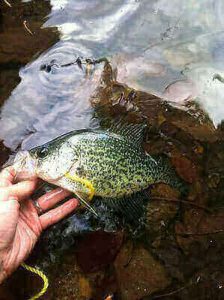
9. Although crappie is a schooling fish, they school by size. If you catch a crappie, there will be many more around. However, they will all be about the same size as the one you initially caught.
10. The best crappie fishing time of the year is the pre-dawn period coming in late winter into spring which is also the beginning of the crappie fishing period.
11. You can find crappie in shallow waters during the warm days of spring.
12. In the summer as the temperature peaks and the water column stabilizes, you can find crappie in the weeds.
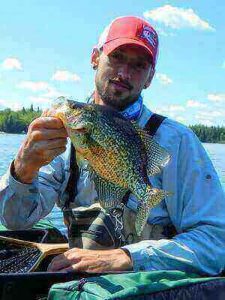
13. In fall, crappie begin to migrate toward deeper water prior to establishing a pattern for winter.
14. Be on the lookout for moving water in spring. The inlets will be warmer and the moving water provides oxygen. This is even more crucial in the ice belt after winter in which oxygen and other resources were depleted.
15. Crappie spawn in mid-May and June. Before this period, crappie is focused on food and warmth; not reproduction.

16. During the actual spawn period, crappie is not focused on food and this will make fishing for crappie more difficult. Hence, you will have better chances of getting crappie by fishing for them before the spawning starts.
17. Use a spring or slip bobber with a small jig or hook. A minnow or worm can be the bait and cast along the shallows.
18. After the spawn phase is when summer crappie patterns change as they are done with reproduction and the water temperatures begin to warm up.
19. Crappies spread out in the post-spawn stage. They will spread throughout the water making it difficult to locate them. They will not be congregated in the shallows or basins like during other times of the year. They often relocate to weed lines or in timber.
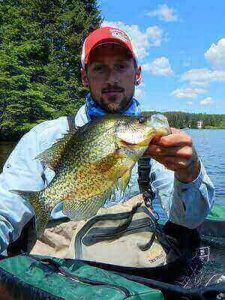
20. Due to their behavior post-spawn, you will have to cover a lot of water to catch crappie.
21. Trolling is one way to target crappie. When trolling, don’t let your line go too deep. Keep it just a few feet above the bottom and go slow.
22. When trolling, use a light split shot or not use a weight. On the snell, you can troll with plastic or worms.
23. In the summer, you can cast for crappie if you locate sunken structures near the shoreline.
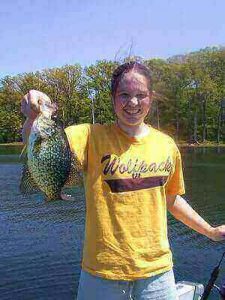
24. In fall, water temperatures start to get colder which will cause crappie to change their patterns. They will go to deeper water. You will have to fish slower with more finesse baits as crappie metabolism slows down. A slow fall rate might lure crappie to rise up and investigate your bait.
25. Ice fishing crappies also come with their challenges. You will find schools of crappie deep and feeding on zooplankton. On the ice, when you see zooplankton, there will be crappie there feeding on them.
26. In lakes covered with thick ice and snow, crappie will migrate the basins, feeding on plankton and moving around in the area.
27. When ice fishing for crappies, they are easy to detect. As they are suspended in search of food, they give away their location.
28. When ice fishing for crappies and come across a basin, if it is warm, punch as many holes across the bowl as you possibly can. This allows you to follow the migrating school of crappies as you target them.
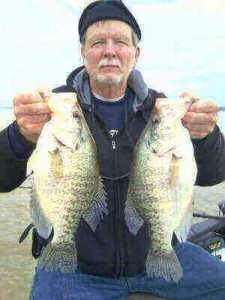
Crappie Gear
1. Lightweight rods
Lightweight fishing rods are indispensable gear for anglers targeting crappies, renowned freshwater game fish prized for their delicious flesh and spirited fights. These specialized rods are designed with sensitivity and finesse in mind, allowing anglers to detect subtle strikes and effectively control the delicate presentation of lightweight lures or bait rigs.
With their flexible and responsive action, lightweight rods enable anglers to cast with precision to specific areas where crappies are likely to be found, such as near submerged structures, weed beds, or drop-offs. The lightweight construction of these rods reduces fatigue during prolonged fishing sessions, making them ideal for anglers who enjoy pursuing crappies for extended periods.
Additionally, their slender profile and sensitive tip provide the finesse needed to handle the often finicky feeding behavior of crappies, resulting in more successful hooksets and landings. Overall, lightweight fishing rods are essential tools for anglers seeking an exhilarating and productive day on the water targeting crappies.
2. Light lines with 4- to 6- pound test.
Light fishing lines are essential gear for anglers targeting crappies, prized freshwater game fish known for their delicate bites and finicky behavior. Typically, anglers opt for lines with low visibility and lightweight construction, such as monofilament or fluorocarbon lines, to minimize detection by wary crappies.
The lightness of these lines allows for the sensitive detection of subtle strikes and enhances the finesse required for the effective presentation of lightweight lures or bait rigs. Furthermore, the low stretch and high sensitivity of these lines enable anglers to detect bites quickly and respond with precise hooksets, increasing the chances of successfully landing crappies.
Light fishing lines also offer superior casting distance and accuracy, allowing anglers to reach specific targets such as submerged structures or weed beds where crappies are known to congregate. Overall, light fishing lines are indispensable tools for anglers seeking to maximize their success when targeting crappies, ensuring an enjoyable and rewarding fishing experience on the water.
3. Small hooks
Small hooks are essential fishing gear for anglers targeting crappies, prized freshwater game fish known for their delicate bites and small mouths. These hooks, typically sized between #6 and #10, are ideal for presenting lightweight lures or bait rigs to crappies without overwhelming their feeding habits.
The small size of these hooks allows for a natural presentation of bait, ensuring that crappies are more likely to strike without suspicion. Anglers often use a variety of baits on small hooks, including live minnows, worms, or insect imitations, to entice crappies into biting.
Additionally, the sharpness of small hooks ensures efficient hooksets, increasing the chances of successfully landing these elusive fish. Overall, small hooks are indispensable tools for anglers seeking to maximize their success when targeting crappies, providing finesse and precision in presenting bait and ultimately leading to a rewarding fishing experience on the water.
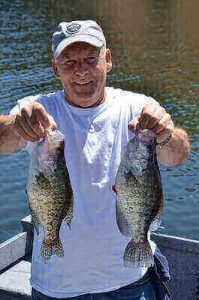
Best Bait For Crappie
1. Minnows
Minnows serve as one of the most effective and popular bait choices for anglers targeting crappies, esteemed freshwater game fish known for their delicious taste and spirited fights. These small fish, typically presented alive on hooks, possess a natural swimming action and enticing scent that attracts crappies in various water conditions.
Anglers often rig minnows on small hooks and allow them to swim freely near submerged structures, weed beds, or drop-offs where crappies are known to congregate. The lifelike movement and scent emitted by minnows provoke aggressive strikes from crappies, making them a preferred bait choice among anglers seeking a successful catch.
Whether suspended beneath a float or slowly retrieved near the bottom, minnows offer versatility and effectiveness in enticing crappies into biting. With their availability at bait shops and proven track record in enticing bites from crappies, minnows remain a reliable and popular bait option for anglers pursuing these prized freshwater game fish, ensuring an enjoyable and rewarding fishing experience on the water.
2. Worms
Worms are a classic and highly effective bait choice for anglers targeting crappies, prized freshwater game fish known for their delectable taste and spirited fights. Whether presented alive or as cut bait, worms emit a natural scent and wriggling motion that entices crappies to strike.
Anglers typically rig worms on small hooks and present them near submerged structures, weed beds, or drop-offs where crappies are known to congregate. The subtle movements of the worm, combined with its irresistible scent, provoke aggressive strikes from crappies, making them a preferred bait option.
Whether fished beneath a float or gently bounced along the bottom, worms offer versatility and effectiveness in enticing crappies into biting. With their widespread availability and consistent success rate, worms remain a reliable and popular bait choice for anglers pursuing crappies, ensuring an enjoyable and rewarding fishing experience on the water.
3. Leeches
Leeches are a lesser-utilized yet highly effective bait option for anglers targeting crappies, prized freshwater game fish known for their delicious taste and spirited fights. These aquatic invertebrates emit a natural scent and movement that entices crappies to strike.
Anglers typically rig leeches on small hooks and present them near submerged structures, weed beds, or drop-offs where crappies are known to congregate. The undulating movement of the leech, combined with its enticing scent, provokes aggressive strikes from crappies, making them a favored bait choice.
Whether fished beneath a float or slowly drifted along the bottom, leeches offer versatility and effectiveness in enticing crappies into biting. While not as readily available as other baits, leeches provide anglers with a unique and productive option for pursuing crappies, ensuring an enjoyable and rewarding fishing experience on the water.
4. Grubs
Grubs, the larvae of various insects, are an often-overlooked yet highly effective bait option for anglers targeting crappies, esteemed freshwater game fish known for their delectable taste and spirited fights. These small, soft-bodied creatures emit a natural scent and subtle movement that entices crappies to strike.
Anglers typically rig grubs on small hooks and present them near submerged structures, weed beds, or drop-offs where crappies are known to congregate. The lifelike movement of the grub, combined with its enticing scent, provokes aggressive strikes from crappies, making them a favored bait choice.
Whether fished beneath a float or slowly retrieved along the bottom, grubs offer versatility and effectiveness in enticing crappies into biting. While not as commonly used as other baits, grubs provide anglers with a unique and productive option for pursuing crappies, ensuring an enjoyable and rewarding fishing experience on the water.
5. Crayfish
Crayfish, with their distinctive appearance and enticing scent, serve as an effective bait option for anglers targeting crappies, esteemed freshwater game fish known for their delectable taste and spirited fights. These crustaceans emit a natural odor and exhibit a subtle movement that entices crappies to strike.
Anglers typically rig crayfish on small hooks and present them near submerged structures, weed beds, or drop-offs where crappies are known to congregate. The lifelike movement of the crayfish, combined with its enticing scent, provokes aggressive strikes from crappies, making them a favored bait choice.
Whether fished beneath a float or slowly retrieved along the bottom, crayfish offer versatility and effectiveness in enticing crappies into biting. While not as readily available as other baits, crayfish provide anglers with a unique and productive option for pursuing crappies, ensuring an enjoyable and rewarding fishing experience on the water.
6. Crickets
Crickets, with their lively movements and distinctive chirping, are an effective and versatile bait option for anglers targeting crappies, esteemed freshwater game fish known for their delicious taste and spirited fights. These small insects emit a natural scent and exhibit erratic movement that entices crappies to strike.
Anglers typically rig crickets on small hooks and present them near submerged structures, weed beds, or drop-offs where crappies are known to congregate. The lively action of the cricket, combined with its enticing scent, provokes aggressive strikes from crappies, making them a favored bait choice.
Whether fished beneath a float or slowly retrieved along the bottom, crickets offer versatility and effectiveness in enticing crappies into biting. With their availability at bait shops and proven success in attracting crappies, crickets provide anglers with a reliable and rewarding option for pursuing these prized freshwater game fish, ensuring an enjoyable fishing experience on the water.
7. Shad
Shad, a popular baitfish found in many freshwater environments, can be an effective choice for anglers targeting crappies, esteemed freshwater game fish known for their delicious taste and spirited fights. These silvery baitfish emit a natural scent and exhibit a lively swimming motion that entices crappies to strike.
Anglers typically rig shad on small hooks or jigheads and present them near submerged structures, weed beds, or drop-offs where crappies are known to congregate. The realistic movement of the shad, combined with its enticing scent, provokes aggressive strikes from crappies, making it a favored bait choice.
Whether fished beneath a float or slowly retrieved along the bottom, shad offer versatility and effectiveness in enticing crappies into biting. With their availability and proven success in attracting crappies, shad provide anglers with a reliable and rewarding option for pursuing these prized freshwater game fish, ensuring an enjoyable fishing experience on the water.
8. Carp
Using carp as bait to catch crappies is an unconventional yet potentially effective strategy for anglers seeking to entice these freshwater game fish. Carp, being larger fish, can be cut into smaller pieces or chunks to serve as bait for crappies.
Anglers typically rig carp bait on small hooks or jigheads and present them near submerged structures, weed beds, or drop-offs where crappies are known to congregate. The scent and oils released from the carp can attract crappies, enticing them to strike.
However, it’s important to note that using carp as bait for crappies may not be legal or permitted in all fishing areas, so anglers should always check local regulations before employing this tactic. While carp may not be the most traditional bait choice for crappies, it can offer anglers a unique and potentially rewarding option for pursuing these prized freshwater game fish.
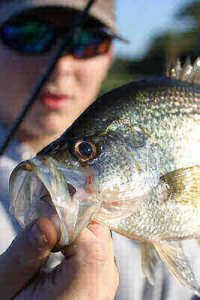
Best Crappie Lures
1. Crankbait
Crankbaits are versatile and effective lures for anglers targeting crappies, prized freshwater game fish known for their delicious taste and spirited fights. These lures typically feature a hard-bodied design with a diving lip that allows them to dive to specific depths in the water column.
Anglers can select crankbaits of varying sizes and colors to match the preferences of crappies in different conditions. By retrieving the crankbait at a steady pace, anglers can simulate the movements of injured baitfish, enticing crappies to strike.
Crankbaits are particularly effective when fished near submerged structures, weed beds, or drop-offs where crappies are known to congregate. With their lifelike action and ability to cover a large area of water, crankbaits offer anglers a reliable and exciting option for pursuing crappies, ensuring an enjoyable and productive fishing experience on the water.
2. Jerkbait
Jerkbaits are a dynamic and effective lure choice for anglers targeting crappies, prized freshwater game fish known for their delicious taste and spirited fights. These lures typically feature a slender, minnow-like profile and are designed to mimic the erratic movements of injured baitfish.
Anglers can manipulate jerk baits with sharp jerking motions of the rod, causing the lure to dart and dive unpredictably through the water. This erratic action can trigger aggressive strikes from crappies, especially when fished near submerged structures, weed beds, or drop-offs where crappies are known to congregate. Jerkbaits come in a variety of colors and sizes to match the preferences of crappies in different conditions.
With their lifelike action and versatility, jerkbaits offer anglers an exciting and effective option for pursuing crappies, ensuring an enjoyable and rewarding fishing experience on the water.
3. Spoons
Spoons are a classic and effective lure choice for anglers targeting crappies, esteemed freshwater game fish known for their delicious taste and spirited fights. These lures typically feature a curved, metallic design resembling a small baitfish or minnow.
Anglers can manipulate spoons with various retrieval techniques, such as a steady retrieve or occasional twitching motion, to imitate the natural movements of injured prey. When fished near submerged structures, weed beds, or drop-offs where crappies are known to congregate, spoons can produce enticing flashes and vibrations that attract crappies to strike.
With their versatility in presentation and ability to cover a large area of water, spoons offer anglers a reliable and exciting option for pursuing crappies, ensuring an enjoyable and productive fishing experience on the water.
4. Jigs
Jigs are perhaps the most versatile and widely used lure choice for anglers targeting crappies, revered freshwater game fish known for their delectable taste and spirited fights. These lures consist of a weighted head typically adorned with a soft plastic or feather tail, mimicking the appearance of small baitfish or insects.
Anglers can present jigs in various ways, such as casting and retrieving, vertical jigging, or under a float, allowing for effective fishing in different water depths and conditions. By imparting subtle movements to the jig, anglers can entice crappies into striking, especially when fishing near submerged structures, weed beds, or drop-offs where crappies are known to congregate. Jigs come in a wide range of colors, sizes, and styles, allowing anglers to match the preferences of crappies in different environments.
With their versatility, lifelike appearance, and proven effectiveness, jigs are a go-to option for anglers pursuing crappies, ensuring an enjoyable and rewarding fishing experience on the water.
The Bottom Line
Crappie is a North American freshwater fish that is abundantly found in most parts of the north. It is considered a tasty fish as well as a sports fish. To be successful with crappie fishing you have to understand its seasonal patterns that will help find and catch them all year long.
Crappie fishing tips like bass fishing tips, sauger fishing tips, or perch fishing tips can be learned, practiced, and get good at it. In this article, we shared some crappie fish tips to help you learn how to catch more crappies and take them home the entire year.

